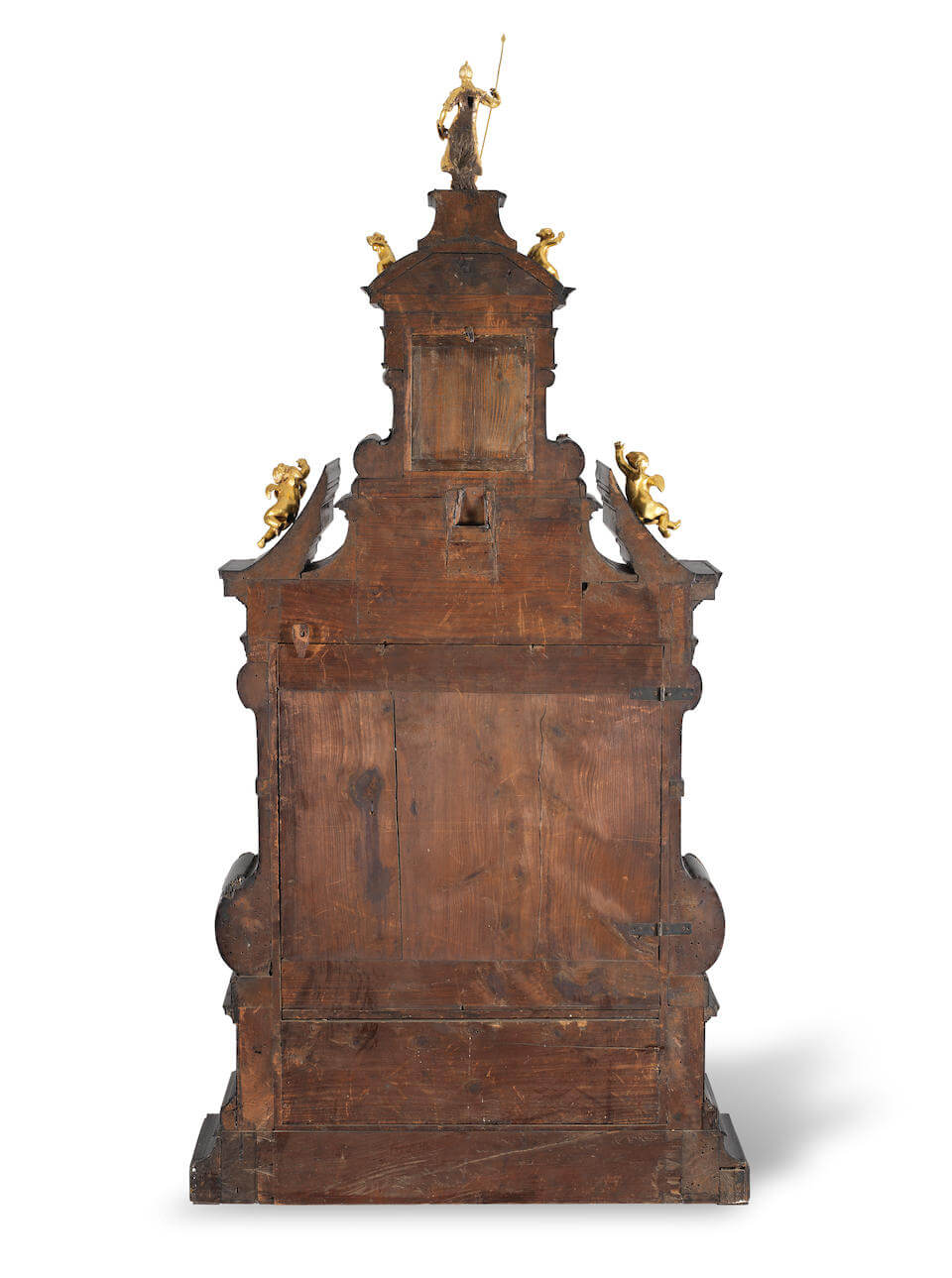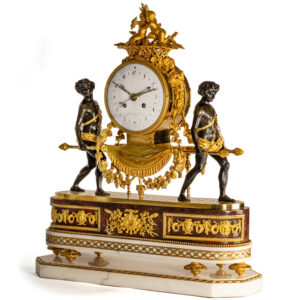A real masterpiece
The gilt bronze figure of Minerva surmounts the magnificent Baroque architectural chest of the night clock. Four cherubs flank the polychrome painted copper panel of the night sky with an elliptical band showing the twelve signs of the zodiac. The main body of the clock is flanked by volutes mounted in gilded metal and by a pair of bronze gilt caryatids incorporating lapis lazuli, with a gilt frame and bronze base.
The central section of the case is dominated by an impressive gilt frame with twelve hard stone inserts surrounding the dial, a copper oil painting in the manner of Filippo Lauri representing the four seasons:
- The allegory of Winter is an older man warming his hands on a brazier.
- Spring is the figure of a woman with a wreath on her head handing out fresh flowers to Father Time.
- Summer is a seated woman resting peacefully with ears of corn in her lap.
- Autumn is represented by a standing young man holding bunches of grapes in his left hand, while with his right arm, he greets Father Time.
All four of them, under the eye of Father Time flying by, a cherub sitting below holding a banner declaring “Volat irreparabile tempus” (Time flies and is irreplaceable).
At the base of the clock, there is a secret drawer with two large inserts in hardstone. The Clock Cabinet is embellished with 26 precious hard-stones inserts in total, including lapis lazuli, quartz, amethyst, agate and Sicilian jasper.
Clock dial and movement
Beneath a semicircular aperture, a revolving disc with two round holes diametrically opposite each other can be seen. Each of these holes reveals a series of hour numeral plates, odd numbers in one and even in the other.
As the main disc revolves once in two hours, one of the two small apertures behind the hour disc is visible in the semicircular opening. When one disc disappears out of view on the right-hand side, the next appears on the left with the appropriate numeral visible. The dial is also pierced around the top of the main aperture with quarters I, II, III and with the half-quarters as pierced inverted tear-drop holes.
The front door panel gives access to the Clock mechanism, which looks like a large spring barrel with a silent crank escapement and a short pendulum. The movement is ingenious in its method of achieving silent operation through driving the three train wheels mounted on stepped taps, terminating in a 5 cm long lead regulator with an eccentric drive to a bell crank via a connecting rod, which terminates in a short bob pendulum mounted with an adjustable friction disc for fine adjustment. The rotation of this keeps the entire mechanism in constant motion and without any ticking.
Clock lighting system
Inside the Cabinet, on the internal rear panel, the original oil lamp is still mounted under the chimney, which allows the heat and fumes to escape at the back. The oil lamp illuminates the revolving system so that the time can be seen in the dark.
Night Clocks oil painting dials
Given the Roman genesis of the Campani brothers’ invention to meet the needs of Pope Alexander VII Chigi, their Silent Clocks were soon appreciated by high clergy, nobility and foreign courts throughout Europe. Thanks to the importance and prestige that this exclusive object conferred on its creators, it was not difficult for the Campani brothers to enrich their valuable silent clocks engaging the most significant and well-known cabinet makers, bronzists, and painters of their time as an example: Filippo Lauri, Giovanni Battista Gaulli, Giacinto Gemignani, Ciro Ferri, Francesco Trevisani and Carlo Maratta.
Hermann’ night clock cabinet
This extraordinary night clock was realized by Giacomo (Jacob) Hermann, a German cabinetmaker active in Rome (1615 Germany, Rome 1685).
He worked for Pope Alexander VII for many years, and his orders book shows that later, Popes also appreciated his work. One of his most important achievements is the magnificent Cabinet in Vienna’s Kunsthistorisches Museum. A gift to Emperor Louis from Pope Alexander VII.
The Cabinet is signed Jacob Hermann fecit Romae 1663, while at the top of the Cabinet there is a splendid night clock signed Petrus Thomas Campanus, inventor Romae in via Peregrini 1663.
The similarities between the two clocks style are evident: the bronze caryatid with lapis lazuli decoration and the hard-stone applications are identical to both clocks. This comparison led to the assumption that the collaboration between Tommaso Campani and Giacomo Ermann also took place to produce our splendid silent clock.
Dial decoration of this Night Clock attributed to Carlo Maratta
The painted quadrant present on this magnificent night clock is attributed to Carlo Maratta (1625-1713), one of the most successful painters in Rome in the late 17th century. After his training in the workshop of Andrea Sacchi, Maratta rapidly became a highly successful and accomplished artist of the period.
“Carlo Maratta decorated a large number of clock dials during the second half of the 17th century. He became especially adept at painting the panels on night clocks, and in the process, rivalled similar works by Baciccio and Trevisani”.
– A. Gonzalez-Palacios, Arredi e Ornamenti alla corte di Roma, Milano, 2004, pg. 104
Pope Alexander VII (1655-1667), who suffered from insomnia and could not stand the ticking of the clock in his bedroom, commissioned the Campani brothers to make a silent clock that could be read even in the middle of the Night thanks to an openwork dial that was illuminated from behind by a small oil lamp or candle.
Pietro Tommaso Campani completed a first prototype in 1656.
The Campani family suddenly found themselves famous and overburdened by numerous orders from important clients such as princes, nobles, ambassadors, and members of the high clergy.
The fashion for Night clocks spread not only in Italy but throughout Europe. Among the Campani’s first illustrious clients were King Philip IV of Spain and his Queen, King John Casimir I of Poland and Grand Duke Ferdinand II of Tuscany.
These sumptuous Silent Clocks was realized in the shape of an altar; a choice made initially because of the need to create a style in keeping with the austere furniture of the Papal bedroom.
It was, therefore, necessary that it conformed to the religious environment, among other things, the style of the ‘reliquary aedicule‘ (a domestic altar or private tabernacle in vogue at the time), was typical in the rich residences and palaces of the Roman nobility and was much sought after as a furnishing element.
Generally, it was dark in color, considering the religious purposes, and made of ebony or other ebonized woods; in some cases, it was decorated with polychrome inserts of hard stone for the most important creations.
The altar structure culminated in a pediment flanked by volutes and had a central copper front panel, often painted with allegorical or religious subjects. Decorative columns or pilasters frequently surrounded the latter. The overall size of the clock was determined by the space required to accommodate the dial panel, which had to be large enough to be read from a distance.
These luxurious and sophisticated altar clocks were aimed exclusively at important and elite clientele and were made by a team of master Cabinet makers, bronzists and painters.
The prestige of owning or donating such precious clocks was also mentioned in the ‘Journal of the chronicle‘ during Bernini’s trip to the court of Louis XIV in 1665. The journal reports that Cardinal Antonio Barberini gave to King Louis XIV of France a night clock made by the Campani brothers.





























